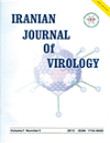The Effect of High Temperature Treatment on Wheat Streak Mosaic Virus Resistance and Certain Resistance-Related Chemicals in Bread Wheat
Author(s):
Z. Zinati , Mt Assad , M. Masumi , A. Alemzadeh , H. Razi , K. Izadpanah
Abstract:
Background And Aims
To evaluate the effect of temperature on wheat streak mosaic virus (WSMV) resistance phenotype, through total protein, phenol, and peroxidase activity in bread wheat, a factorial experiment was conducted using Adl-Cross (resistant) and Marvdasht (susceptible) cultivars. Materials And Methods
Results showed that incubation at 32°C changed the gene expression for resistance to WSMV and mosaic symptoms were observed in Adl-Cross. Total protein reduction in inoculated Adl-Cross was significant at 32°C. Results also indicated that high temperature either prevented expression of genes or degenerated available proteins involved in resistance mechanism. Total protein in infected Marvdasht was significantly reduced as compared with healthy control plants. Since electrophoretic pattern indicated reduction of ribulose 1, 5-bisphosphate carboxylase (RBPC) subunits in infected Marvdasht, reduction of protein may have probably been due to a decrease in the synthesis of RBPC. Mean of phenolic compounds content in Adl-Cross was higher as compared to Marvdasht in both infected and non-infected plants. Total phenol increased 2.8 and 4.06 percent in inoculated Marvdasht and Adl-Cross, respectively. The trend of increase in phenolic compounds indicated that their synthesis and accumulation was higher in Adl-Cross as compared to Marvdasht. Results
These results indicated the role of phenolic compounds in prevention of viral movement and spread in resistant cultivar. Thin-layer chromatography (TLC) analysis showed that the intensity of a spot with Relative flow (Rf) 0.622 increased at high temperature. Increase in total phenol at high temperature may have been due to increase in intensity of this spot. Spot concentration with Rf 0.622 at high temperature was higher in infected samples as compared to uninfected samples. Conclusion
This showed an interaction of virus and temperature. Also, a spot with the same Rf and different color was observed 8 days after inoculation at 25°C. The color change in this spot showed that high temperature might cause a decrease in concentration of phenolic compounds which are in turn effective in resistance to WSMV. Another possibility is that the compounds effective in resistance of Adl-Cross are changed to neutral forms at higher temperatures. There were no significant differences between genotypes for peroxidase activity in healthy plants at 25°C. Viral infection reduced the peroxidase activity in Marvdasht but, showed a significant increase in Adl-Cross. High temperature reduced peroxidase activity in both infected and uninfected plants. Peroxidase enzyme probably affects synthesis of compounds effective in resistance. Also, reduction in enzyme activity at high temperature increased reactive oxygen species (ROS) and this led to oxidative stress.Language:
English
Published:
Iranian Journal of Virology, Volume:6 Issue: 1, 2012
Pages:
27 to 35
magiran.com/p1107691
دانلود و مطالعه متن این مقاله با یکی از روشهای زیر امکان پذیر است:
اشتراک شخصی
با عضویت و پرداخت آنلاین حق اشتراک یکساله به مبلغ 1,390,000ريال میتوانید 70 عنوان مطلب دانلود کنید!
اشتراک سازمانی
به کتابخانه دانشگاه یا محل کار خود پیشنهاد کنید تا اشتراک سازمانی این پایگاه را برای دسترسی نامحدود همه کاربران به متن مطالب تهیه نمایند!
توجه!
- حق عضویت دریافتی صرف حمایت از نشریات عضو و نگهداری، تکمیل و توسعه مگیران میشود.
- پرداخت حق اشتراک و دانلود مقالات اجازه بازنشر آن در سایر رسانههای چاپی و دیجیتال را به کاربر نمیدهد.
In order to view content subscription is required
Personal subscription
Subscribe magiran.com for 70 € euros via PayPal and download 70 articles during a year.
Organization subscription
Please contact us to subscribe your university or library for unlimited access!


